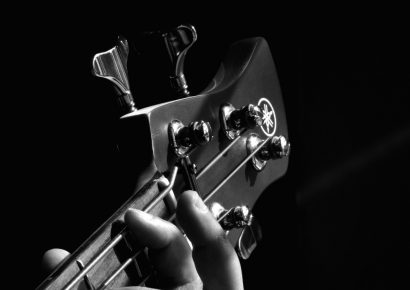Taking a DI for guitar and bass doesn’t have to mean you don’t intend to get the sound right at the source, and I think that’s a good thing to keep in mind.
When you take a guitar DI, you’re not only safeguarding your recording, but you’re creating a blueprint for guitar and bass to follow, because the signal is so clean, and the transient so visually obvious.
This is endlessly helpful when editing, comping and mixing, as you’ve got an unaffected signal to reference against, then mix in or out to taste.
While taking guitar DI to re-amp entire songs is a personal workflow preference, having the DI there just in case is simply good practice.
Yes, DIs are often used for re-amping, but it’s important to remember that re-amping doesn’t have to be replacing entire guitar tracks, but instead can be used to enhance and augment existing rhythm or lead guitar tracks that are already recorded.
The beauty of a clean signal is that it is just that – a signal clean enough to be used as subtlety or overtly as you like, and everything in between. You don’t even need to use the DI track in mixing, but it’s a very handy tool to help you get through a song or entire album.
Read all the latest features, columns and more here.
Tube saturation and room sound fill in the gaps between notes in audio files and the more saturated or distorted the amplifier you’re recording may be – regardless of whether or not the transient remains sonically – it won’t remain visually, which is primarily what we use for editing and comping.
A clean DI recording, especially one with plenty of headroom and a low noise-floor thanks to a great quality DI box, offers an unparalleled transient that makes editing a breeze.
Tracks can be grouped together in your DAW of choice, and the DI can even be muted or turned right down and used solely for editing. This allows us to cut, fade and comp the perfect take much faster, because we’re not over-analyzing our edit and cross-fade points, and as confidence is key, the clearer transients give us that.
Stereo guitars and double tracked rhythms and layers can be nudged and comped far more accurately when you’ve got that super tight transient, and you can really make sure that your phase is super tight (or purposely out of alignment) across any amount of mics as long as you have your D.I. as reference.
Fast leads can be more accurately edited when need be, as the transient of each note can more clearly be seen for editing. The DIs, once edited together with our amp tracks, can become very useful in mixing.
While this may fall under the umbrella of re-amping, previously static guitar tracks can be enhanced depending on the playing style and the section of a song. A nice clean DI from a guitar can be used to make a lead more articulate or clean up the frequency range of a distorted guitar, similar to how a clean bottom end on a bass might be blended in.
The infamous Ibanez Tubescreamer works by blending in a portion of your clean signal alongside the clipping silicon diodes of this historical circuit, so take a leaf out of their book and think about how a subtle blend of a clean signal can help your next mix.
A cohesive and uniform guitar tone is an increasingly common trait of a lot of contemporary music, and a clean DI can assist in bringing a uniformity to your tracks. While guitars, pedals, mics and amps may differ from song to song, a subtle mix of a uniform guitar tone beneath all of these can create an overarching vibe and bring it all together.
However, it’s really important to think about your phase when blending DI signals into guitar tracks, as even a mic an inch away from a speaker cone can be delayed enough to muck up your carefully crafted tone.
In saying this, a little delay can sometimes give your entire tone some breathing room, giving it space and enough delay for the ear to hear the whole frequency spectrum without those frequencies clashing.
One instrument that this works particularly well for is the bass guitar, which can be one of the toughest elements to tame in a mix. Bass sometimes requires a few different tones even within one song, ironically so it all sounds and feels cohesive in the bottom end.
Without a DI, this may be a bit of an arduous task, requiring automation, further EQ and effects to a fairly static amplifier sound, whereas a DI serves to augment the tone captured from a bassist’s amplifier rig.
Rhythm guitars can be bought back to life by a little blend of their clean signal here and there, and can inversely be used to muddy up sections by taking the clean signal away when need be. Static rhythms can be the back bone of a song, and a subtly blended clean signal can prove to be the difference between good and great rhythms.
If you don’t take that DI in the first place, you may be stuck trying to EQ in some life or add some effects in post. What’s that they say about leaving things to ‘fix in the mix’?
All in all, these are just a bunch of little tricks and tips to keep your recordings and mixes moving. Maybe you’ll use your DI one out of ten sessions, but you can bet on that tenth session you’ll be glad you have it.
A DI’d guitar is a handy tool for referencing your recordings when editing, or blending a little clean signal in to taste here and there to re-invigorate static rhythms and leads.
Transients can be edited right on the note, and confidently pulled in tighter to whatever transient they’re supposed to strike with. Guitar effects can be blended in parallel without the gain and effects of your amp tone, which allows you to get amp tones from the amp, without fear of not being able to undo them.
Guitar and bass DIs allow you to get it right at the source, as well as safeguard yourself because, as we’ve all experienced, things can go awry pretty quickly in the studio.
Never miss a story – sign up to our mailing list for all the latest news, reviews, features and giveaways.







